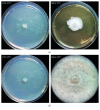Saksenaea dorisiae sp. nov., a New Opportunistic Pathogenic Fungus from Europe
- PMID: 31662760
- PMCID: PMC6778886
- DOI: 10.1155/2019/6253829
Saksenaea dorisiae sp. nov., a New Opportunistic Pathogenic Fungus from Europe
Abstract
A new species, Saksenaea dorisiae (Mucoromycotina, Mucorales), isolated from a water sample originating from a private well in Manastirica, Petrovac, in the Republic of Serbia (Europe), is described and illustrated. The new taxon is well supported by multilocus phylogenetic analysis that included the internal transcribed spacer (ITS) region, domains D1 and D2 of the 28S rRNA gene (LSU), and translation elongation factor-1α gene (tef-1α), and it is resolved in a clade with S. oblongispora and S. trapezispora. This fungus is characterized by its moderately slow growth at 15 and 37°C, sparse rhizoids, conical-shaped sporangia, and short-cylindrical sporangiospores. Saksenaea dorisiae is a member of the opportunistic pathogenic genus often involved in severe human and animal mucormycoses encountered in tropical and subtropical regions. Despite its sensitivity to several conventional antifungals (terbinafine and ciclopirox), the fungus can potentially evoke clinically challenging infections. This is the first novel taxon of the genus Saksenaea described from the moderately continental climate area of Europe.
Copyright © 2019 Roman Labuda et al.
Conflict of interest statement
The authors declare that there are no conflicts of interest regarding the publication of this paper.
Figures





Similar articles
-
Detection and isolation of a new member of Burkholderiaceae-related endofungal bacteria from Saksenaea boninensis sp. nov., a new thermotolerant fungus in Mucorales.IMA Fungus. 2023 Nov 23;14(1):24. doi: 10.1186/s43008-023-00129-2. IMA Fungus. 2023. PMID: 37996922 Free PMC article.
-
Molecular phylogeny and proposal of two new species of the emerging pathogenic fungus Saksenaea.J Clin Microbiol. 2010 Dec;48(12):4410-6. doi: 10.1128/JCM.01646-10. Epub 2010 Oct 6. J Clin Microbiol. 2010. PMID: 20926710 Free PMC article.
-
Saksenaea erythrospora, an emerging mucoralean fungus causing severe necrotizing skin and soft tissue infections - a study from a tertiary care hospital in north India.Infect Dis (Lond). 2017 Mar;49(3):170-177. doi: 10.1080/23744235.2016.1239027. Epub 2016 Oct 4. Infect Dis (Lond). 2017. PMID: 27701965
-
Coniochaeta massiliensis sp. nov. Isolated from a Clinical Sampl28.J Fungi (Basel). 2022 Sep 23;8(10):999. doi: 10.3390/jof8100999. J Fungi (Basel). 2022. PMID: 36294564 Free PMC article.
-
Taxonomy and Phylogeny of Four New Species in Absidia (Cunninghamellaceae, Mucorales) From China.Front Microbiol. 2021 Aug 4;12:677836. doi: 10.3389/fmicb.2021.677836. eCollection 2021. Front Microbiol. 2021. PMID: 34421840 Free PMC article.
Cited by
-
Evaluation of two MALDI-TOF MS systems and extraction methods for identification of filamentous fungi recovered from clinical specimens.J Clin Microbiol. 2025 Feb 19;63(2):e0154824. doi: 10.1128/jcm.01548-24. Epub 2025 Jan 14. J Clin Microbiol. 2025. PMID: 39807897 Free PMC article.
-
Disseminated Saksenaea infection in an immunocompromised host associated with a good clinical outcome: a case report and review of the literature.BMC Infect Dis. 2020 Oct 14;20(1):755. doi: 10.1186/s12879-020-05459-9. BMC Infect Dis. 2020. PMID: 33054720 Free PMC article. Review.
-
Detection and isolation of a new member of Burkholderiaceae-related endofungal bacteria from Saksenaea boninensis sp. nov., a new thermotolerant fungus in Mucorales.IMA Fungus. 2023 Nov 23;14(1):24. doi: 10.1186/s43008-023-00129-2. IMA Fungus. 2023. PMID: 37996922 Free PMC article.
-
Hyphae of Rhizopus arrhizus and Lichtheimia corymbifera Are More Virulent and Resistant to Antifungal Agents Than Sporangiospores In Vitro and in Galleria mellonella.J Fungi (Basel). 2023 Sep 23;9(10):958. doi: 10.3390/jof9100958. J Fungi (Basel). 2023. PMID: 37888214 Free PMC article.
-
Invasive Fungal Diseases of Combat Wounds: Burden, Epidemiology, and Mycology.Mycopathologia. 2024 Nov 21;189(6):102. doi: 10.1007/s11046-024-00908-4. Mycopathologia. 2024. PMID: 39570484 Free PMC article. Review.
References
LinkOut - more resources
Full Text Sources

